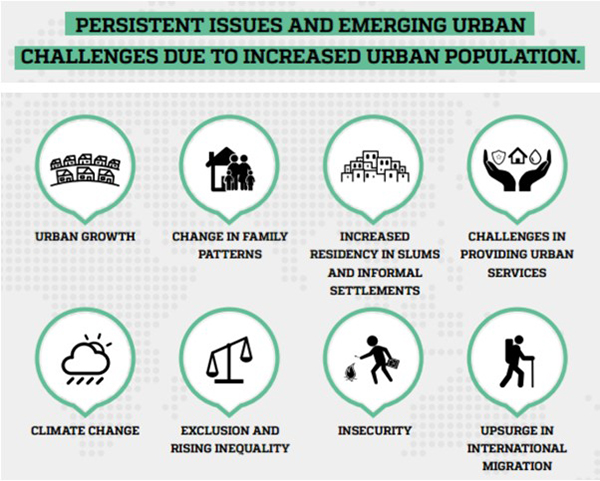Date: 04/04/2023
Relevance: GS-2: Government Policies and Interventions for Development in various sectors and Issues arising out of their Design and Implementation.
Key Phrases: Megacity, Sustainable Development Goals, Public-private partnerships, municipal bonds and green bonds, urban local bodies (ULBs), tier-2 and tier-3 cities, UN World Cities Report.
Context:
- The UN’s Sustainable Development Goals Report, 2022, states that
by 2050, seven out of 10 people are likely to be living in urban areas.
As the UN World Cities report highlights, we expect the present population of urban areas to increase from 55% to 68% by 2050.
What is a Megacity?
- To qualify as a megacity under the UN definition, an urban area must have a population of 10 million people.
- The UN takes into account urban sprawl and measures populations beyond official city limits. On these criteria, India currently has five megacities:
New Delhi, Bengaluru, Chennai, Kolkata and Mumbai
- Other urban areas in India are growing rapidly as people look to cities for jobs and financial security, as well as the chance of a better education for their children.
- This rural-to-urban migration will result in two more urban areas
becoming megacities by 2030, says the UN.
- Hyderabad: A strong IT hub and tourism centre. It may be home to 12.8 million by 2030
- Ahmedabad: The heart of the textile industry is expected to house 10.5 million by 2030
Source: World Economic Forum
Why focus on financing cities in India?
- The urban population of Indian cities is projected to reach near 60%
from 31% (2011) by 2050.So cities need to be better planned, with
infrastructure focussed on spatial, social and economic inclusion.
- Spatial and social inclusion would mean providing affordable necessities, such as housing and water.
- Economic inclusion would include jobs. Indian cities will need capital investment of $840 bn by 2036 in infrastructure and municipal services.
What are the sources of such finances?
- Indian cities occupy just 3% of the nation’s land but contribute over 60% to its gross domestic product (GDP).
- With growing urbanization, revenue from tax and non-tax sources and grants from central and state governments are proving to be insufficient.
- Public-private partnerships, issuance of municipal bonds and green bonds by urban local bodies (ULBs), land value capture in terms of additional floor space index etc., could be the alternative financing sources. Also, local bodies could look at recovering user charges for sanitation, water etc.
What steps has the central government taken?
- The Union budget proposed an urban infrastructure development fund of ₹10,000 crore per year for public agencies to create infrastructure in tier-2 and tier-3 cities.
- Other measures include safe and dignified sanitation, state-led investment for urban development and incentivizing cities to increase their creditworthiness for municipal bonds.
What are municipal bonds?
- Municipal bonds are similar to corporate bonds, but they are issued by civic bodies to finance urban infrastructure projects.
- Municipal corporations issue bonds to raise funds from individuals and institutions. The investors are promised a specified interest and return of the principal amount on the maturity date.
- The bonds can be issued by states, cities, counties, utility providers, transit authorities, school districts, and hospitals.
What is the status of municipal bonds?
- The municipal bond market has been an untapped source of financing which the urban local bodies are trying to build on.
- The NSE has 28 municipal bonds issued by 10 cities—Pune, Hyderabad, Indore, Amravati, Bhopal, Visakhapatnam, Ahmedabad, Surat, Ghaziabad and Lucknow. As per reports, the government has identified over 30 cities with good ratings in the municipal bond market. The Indore Municipal Corporation, this year, became the first city to issue green bonds on the NSE.
- According to the Prime Database, municipal corporations raised Rs 3,991 crore through bond issues from 2013 to 2022.
- The municipal corporations of Greater Hyderabad, Indore, Bhopal and Greater Visakhapatnam were among those that together raised Rs 2,790 crore in 2018. In 2022, Vadodara municipal corporation was the sole issuer and raised Rs 100 crore.
- The Indore municipal corporation’s issue of green bonds, which opened for subscription on February 10, intends to raise up to Rs 244 crore to fund a solar power project.
What more sources can be there?
- Commercial debt financing, including loans and bonds, is one option. Any bond purchase is done with three aspects in mind: return on investment, whether the bond has sovereign backing, and if there is a tax incentive.
- A sovereign backing gives confidence to investors and the government could provide a guarantee. Making them tax-free couldn’t hurt—tax benefits for interest income or capital gains for instance.
Way Forward:
- New forms of collaboration and cooperation, planning, governance, finance and learning can sustain positive change. They demonstrate that the current urbanization model is unsustainable.
- The message is that the pattern of urbanization must change in order to respond to the challenges of our time, to address issues such as inequality, climate change, informality, insecurity, and unsustainable forms of urban expansion.
Conclusion:
- Big cities "create wealth, generate employment and drive human progress". On the downside, megacities are also responsible for driving climate change, inequality and exclusion, as well as the breakdown of traditional family structures, which leaves elderly people isolated and vulnerable.
Source: Live-Mint
Mains Questions:
Q. “Megacities have mega challenges to meet.” Elaborate.






















